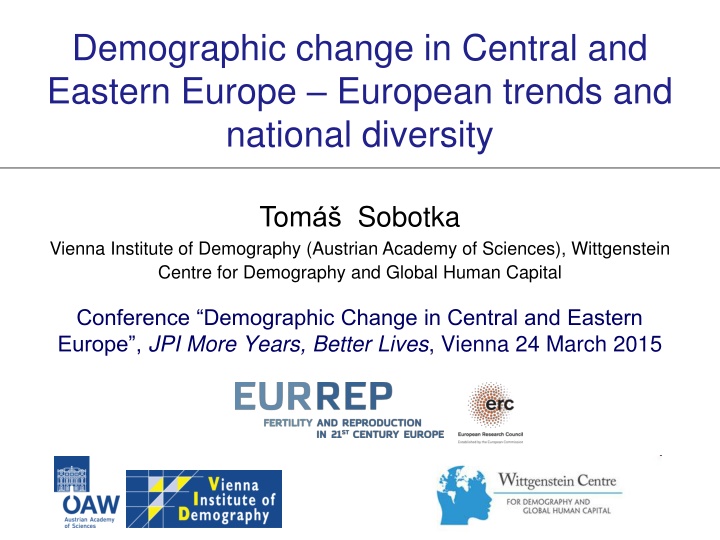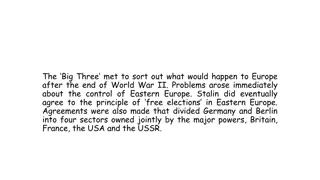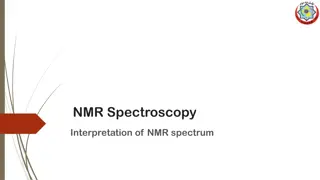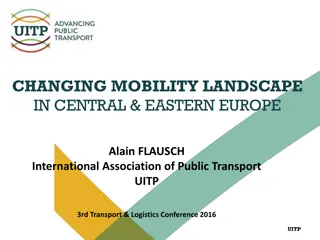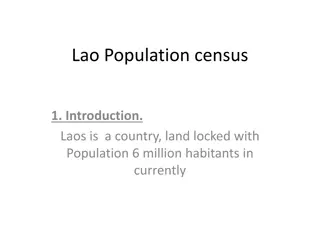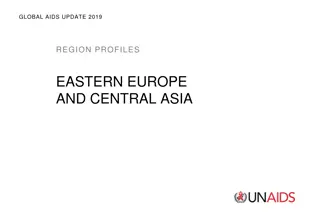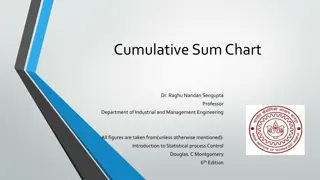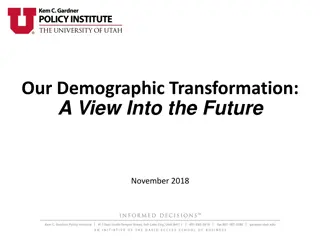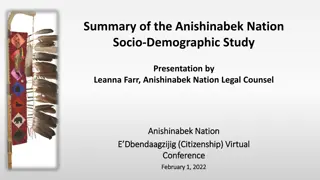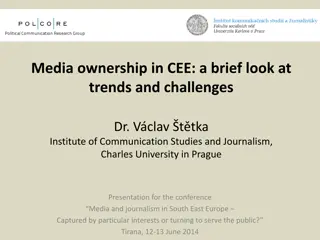Demographic Shifts in Central and Eastern Europe Post-1989: A Closer Look
The collapse of state socialism in Central and Eastern Europe in 1989-91 brought about significant changes, leading to economic and social transformations. The region experienced new political and economic freedoms, although inequalities grew. Unique demographic divides between East and West Europe emerged, impacting family structures, healthcare, and migration patterns. Pronatalist policies and slow population growth further shaped the demographic landscape in the region.
Download Presentation

Please find below an Image/Link to download the presentation.
The content on the website is provided AS IS for your information and personal use only. It may not be sold, licensed, or shared on other websites without obtaining consent from the author.If you encounter any issues during the download, it is possible that the publisher has removed the file from their server.
You are allowed to download the files provided on this website for personal or commercial use, subject to the condition that they are used lawfully. All files are the property of their respective owners.
The content on the website is provided AS IS for your information and personal use only. It may not be sold, licensed, or shared on other websites without obtaining consent from the author.
E N D
Presentation Transcript
Demographic change in Central and Eastern Europe European trends and national diversity Tom Sobotka Vienna Institute of Demography (Austrian Academy of Sciences), Wittgenstein Centre for Demography and Global Human Capital Conference Demographic Change in Central and Eastern Europe , JPI More Years, Better Lives, Vienna 24 March 2015
The Big Bang in 1989-91 The collapse of state-socialism in 1989-91 The system has become sclerotic, obsolete, unable to reform itself Europe s post-war political and economic order Complete economic & social transformation, deeply affected the lives of all the people New political and economic freedoms (including freedom to travel), new opportunities, market orientation and restructuring, economic uncertainty Less paternalism, more inequality Zygmund Bauman (1990: 187) What [Communism] could not do and did not brace itself to do was to match the performance of the capitalist market-centred society once that society abandoned its steel mills and coal mines and moved into the postmodern age Soviet communism, as if to cast out devils, spent its energy on fighting wide trousers, long hair, rock music
European demographic divides, 1980s Main demographic divisions and cleavages, East and West of Europe, 1980s CEE contrasted with Western & Northern Europe: Family and marriage almost universal, voluntary childlessness rare Early family formation (unplanned pregnancies, shotgun weddings) Higher mortality, stagnating health care Restricted international migration (Iron Curtainwas real ) The absence of the Second Demographic Transition in the East Less rapid pace of population ageing Pronatalist family policies (only limited effect), often limited birth control, widespread abortion Both East & West Slow population growth, long-term shift to sub-replacement fertility 2-child family norm
CEE divisions (1) Eastern Europe / former USSR (ex. Baltic countries Map creator: http://edit.freemap.jp/en EU accession countries ((1990), 2004, 2007, 14) Other countries / the Balkans
European divisions 1 (broader geographical regions) Eastern Europe / former USSR (ex. Baltic countries Nordic countries Central Europe Western Europe German-speaking countries (DACH) South-eastern Europe Southern Europe Map creator: http://edit.freemap.jp/en
European divisions 2 (historical / cultural divisions) Source: Norman Davies. 1997. Europe: A history. London: Pimlico / Random House.
CEE diversity. New and re-emerging between- country differences and fault lines (1) GDP per capita, current prices, US $, 2010-14 (source: World Bank)
CEE diversity. New and re-emerging between- country differences and fault lines (2) GDP per capita, current prices, US $, 2010-14 (source: World Bank) Human Development Index, 2013 (source: UN; http://hdr.undp.org/en/data)
CEE diversity. New and re-emerging between- country differences and fault lines (3) World Happiness Ranking, UN/Gallup 2010-12 (85 countries); Source: http://en.wikipedia.org/wiki/ World_Happiness_Report
Agenda The Big Bang: reproduction transformed after 1989 Migration and population decline Mortality and health: diverging trends Population ageing: fastest in Europe? Our nation is dying : The policy debates and responses Discussion: The new CEE diversity?
The big bang: reproduction transformed after 1989 economistmom.com
The fertility collapse and its slow recovery Period Total Fertility Rates, selected CEE countries, 1985-2010 1990s: seemingly uniform sharp fertility declines across CEE 2000s: partial fertility recovery 2008-12: differentiated reactions to the economic recession Sources: Human Fertility Database, National statistical offices, Sobotka 2011
Period Total Fertility in broad European regions: North & West vs. South & Centre & East Source: European Demographic Data Sheet 2014 (VID/WIC 2014)
Mean age of mother at first birth, 1950-2011 (the Netherlands compared with five CEE countries) 30.0 Czech Republic Slovakia Estonia Bulgaria Hungary Slovenia Russia The Netherlands 29.0 28.0 27.0 Mean age at first birth 26.0 25.0 24.0 23.0 22.0 21.0 20.0 1950 1955 1960 1965 1970 1975 1980 1985 1990 1995 2000 2005 2010 Source: Human Fertility Database, National statistical offices, Sobotka 2011
Cohort fertility trends and variation Observed and projected completed cohort fertility in selected regions in Europe, East Asia and in the United States, 1970-2012 2.20 2.00 1960 1.80 1.60 1970 1.40 1979 1.20 1.00 Nordic countries Western Europe Central & Eastern Europe Germany, Austria, Switzerland Southern Europe United States East Asia Myrskyl , M., J. Goldstein, and Y. Alice Cheng. 2012. New Cohort Fertility Forecasts for the Developed World: Rises, Falls, and Reversals. Popul. Dev. Rev. 39 (1): 31 56.
A rapid increase in one-child families Share of women with a small family size (0 or 1), cohorts 1960 and 1970 (%) S. Basten, T. Frejka et al. 2015. Fertility and Family Policies in Central and Eastern Europe. Barnett Papers in Social Research 15-01; Table 5.
The explosion of non-marital childbearing (%) Bulgaria Estonia Russia Czech Republic Slovenia Hungary East Germany Romania Croatia Northern & Western Europe West Germany 60 50 Percent nonmarital births 40 30 20 10 0 1985 1990 1995 2000 2005 2010 Source: Eurostat, National statistical offices, Sobotka 2011
Marriage postponed or foregone? First marriage intensity among women in 5 CEE countries, France and Netherlands, 1990-2012 (indicators based on first marriage table) 1.00 1.00 Czech Republic Lithuania Slovenia France Hungary Romania Netherlands Probability ofmarrying before reaching age 25 0.90 0.90 Total first marriage intensity (table indicator) 0.80 0.80 0.70 0.70 0.60 0.60 0.50 0.50 0.40 0.40 0.30 0.30 Czech Republic Lithuania Slovenia France Hungary Romania Netherlands 0.20 0.20 0.10 0.10 0.00 0.00 1990 1994 1996 2000 2002 2006 2008 2012 1992 1998 2004 2010 1992 1994 1998 2000 2004 2006 2010 2012 1990 1996 2002 2008 Total first mar. intensity (per woman) Probability of marrying < age 25 Source: Computed by Caroline Berghammer, based on Eurostat (2015) database
Mortality and Health: diverging trends Kremikovtzi steel mill area, suburbs of Sofia Source: http://phys.org/news/2014- 02-bulgaria-air-pollution- fuelled-poverty.html
East-West and East-East contrasts in life expectancy at birth, males, 1960-2012 Data source: Eurostat 2015, Council of Europe 2006, Vishnevsky 2013, Tab. 8.2
Life expectancy at birth: Female mortality advantage (years) Data source: Eurostat 2015, Council of Europe 2006, Vishnevsky 2013, T8.2
Why some countries having so negative trend in mortality in the 1990s A combination of lifestyle factors + economic factors; also a collapse or a deterioration of the healthcare system A spike in cardiovascular diseases, ischemic hearth diseases, external causes (incl. suicide), cancer (esp. Hungary) Data source: WHO and EC Report 2002; http://ec.europa.eu/health/ph_projects/1999/monitoring/health_status_overview_en.pdf
Migration and population decline Source: European Parliament, http://www.europarl.europa.eu
The incredible shrinking region? Population change since the 1990s: The triple forces of falling or low fertility, negative migration balance, and in some regions high mortality, esp. of men Huge differences in migration & mortality trends Cumulative pop. Decline 1989-2012/13: ca 23 million out of 360 million Emigration driven by the economic slump, uncertainties & low living standards combined with the lifting of the travel restrictions EU members: access to labour market & social protection in other countries (with a delay) fuelled increased migration Also the effects of the recession, 2008-12 Unreliable data, frequent undercounts, adjustments at the Census Rough estimate of net migration loss, without Russia: 8-10 million in 1989-2013 out of pop. 212 mill (including eastern Germany); 6-8 million ex. Eastern Germany; Russia: migr. gain of 8.3 mill in 1989-2012
East-West division in relative population change, 1989-2013, in % Decline 15-25% Decline 10-14% Increase 10-19 % Increase 20+ % Data source: Own elaboration of Eurostat 2015 Map creator: http://edit.freemap.jp/en
Relative population change, 1989-2012 or 2013: Net migration vs. Natural pop. increase 25.0 20.0 15.0 Net migration 10.0 Population growth, in % 5.0 0.0 -5.0 -10.0 Natural increase -15.0 -20.0 -25.0 -30.0 Data source: Eurostat 2015, national statistical offices, www.pdwb.de
Managing population decline & ageing Depopulating towns in Eastern Germany Older streets are gap-toothed where wreckers have removed abandoned houses. Cityscapes are being pruned, removing dead and dying edifices in the hope of saving the rest. Tearing itself down Economist, April 10, 2008 Aschersleben, Saxony-Anhalt Source: The Economist, http://www.economist.com/node/11025721
Regional differences in population change: the drive of the capital cities? Average rate of population change (per thousand), NUTS-2 regions in Europe, 2008-12 Source: Eurostat database, http://ec.europa.eu/eurostat/statistics-explained, picture RYB14.png; accessed 23 March 2015
Sex- and age-specific differentials in migration In most countries migration strongly concentrated into ages 18-35 Also sex differentials Highly educated leave more frequently Strong effects on reproduction/number of births, labour force size and human capital distribution of the population
Sex- and age-specific differentials in migration In most countries migration strongly concentrated into ages 18-35 Also sex differentials Highly educated leave more frequently Number of women per 100 men aged 18-27 in German districts, 2007 Strong effects on reproduction/number of births, labour force size and human capital distribution of the population The left over men in eastern Germany Source: Berlin Institute 2010, http://www.berlin- institut.org/publikationen/studien/not-am-mann.html
Population ageing: fastest in Europe? Source: http://blog.ted.com/a-story- of-people-not-radiation-a- conversation-about- chernobyl-and-fukushima/
Projected changes in old-age dependency ratios in NUTS-2 regions of Europe, 2005-50 Rees, P. et al. 2012. European regional populations: current trends, future pathways, and policy options. European Journal of Population 28(4), 385-416.
Prospective old-age dependency ratio, projected, 2030 Source: VID/Wittgenstein Centre 2012: European Demographic Data Sheet 2012
Our nation is dying: The policy debates and responses Source: somatosphere.net
Many governments think fertility is too low Government view on fertility level and government policy on fertility in 22 countries ever reaching a period total fertility of 1.40 or below, 1996-2011 22 Number of countries with a given view 20 18 16 14 12 10 8 Fertility too low 6 4 Policy to raise fertility 2 0 1996 2001 2003 2005 2007 2009 2011 Source: Sobotka 2013; based on UN reports & UN World Population Policy Database; http://esa.un.org/PopPolicy/about_database.aspx
Public family & population policy discussions: different ideological underpinning Demography high in political agenda in CEE Family policies: the previous ones partly collapsing or abandoned Policy reorientation often driven by ideological considerations & perceived need to lower government expenditures 1990s: declining childcare availability; shift to the more traditional support of the prolonged stay of mothers at home Policy turbulences; lacking coherence, frequent changes Hungary: the least effective family policies ? Eastern and SE Europe: the return of explicit pronatalism Russia, Ukraine, Belarus: strong support for 2nd & higher- order births (RUS: maternal capital ; UKR: high childcare allowances) BG: nationalistic discussion on Bulgaria s collapse coloured by strong anti-Roma sentiments (Kotzeva & Dimitrova 2014)
Selected policy trends in the EU-CEE countries after 2000 EU policies: also motivated by enabling people to fulfill their fertility intentions; not explicitly pronatalist A slow expansion of public childcare coverage for children below age 3 (EU target to achieve at least 33% coverage in each country) Shorter, but better paid parental leave, with remuneration up to 100% of the previous wage (Estonia, Poland). Stimulating earlier return to employment Flexible leave arrangements: more flexibility in selecting leave period, multispeed leave (Czech Republic) Cash support to newborns and children: childcare allowances in Ukraine, maternity capital established at the time of child s birth (second births in Russia) Tax rebates
Policies addressing population ageing Shifts to older retirement age in all countries; also abandoning the earlier retirement age among women Limited or ineffective policies on retaining older workers; widespread prejudices and discrimination The elderly bias in public spending
The elderly bias in social spending, OECD, 2007-8 Most pro- elderly biased countries: Poland, Greece, Italy, Slovakia, Czech Rep., Portugal, Slovenia, Austria, EBiSS>5 SOURCE: Vanhuysse, P. 2013. Intergenerational Justice in Aging Societies. A Cross-national Comparison of 29 OECD Countries. G tersloh: BertelsmannStiftung, p. 27. www.sgi-network.org/pdf/Intergenerational_Justice_OECD.pdf
Discussion: The new CEE diversity?
The new CEE demographic diversity The CEE as a distinct demographic region no longer exists New & re-emerging differences Often more differentiation in population trends and behaviours than other parts of Europe: Migration, health & mortality, marriage trends, but also family-related values and attitudes Surprisingly conservative and paternalistic gender attitudes and practice Declining population in much of the region (except parts of Central Europe), rapid pace of aging Vastly different experiences with shrinking populations: emigration key Emigration combined with low fertility implies rapid pop. declines in Baltic countries, south-eastern Europe, and some ex-USSR countries Countries with only low fertility experiencing much more gradual trends (ex. Ukraine)
The importance of education transition Rapid rise in tertiary education enrollment across the region, esp. among women A key explanation of postponed family formation & lower fertility Large education gradient in family size Also more effective contraceptive use Gender gap in tertiary education at age 30-34, Europe 2011 Source: VID/Wittgenstein Centre 2014: European Demographic Data Sheet 2014
tomas.sobotka@oeaw.ac.at Work on this presentation was funded by the European Research Council under the European Union s Seventh Framework Programme (FP7/2007-2013) / ERC Grant agreement n 284238 (EURREP). EURREP website: www.eurrep.org
